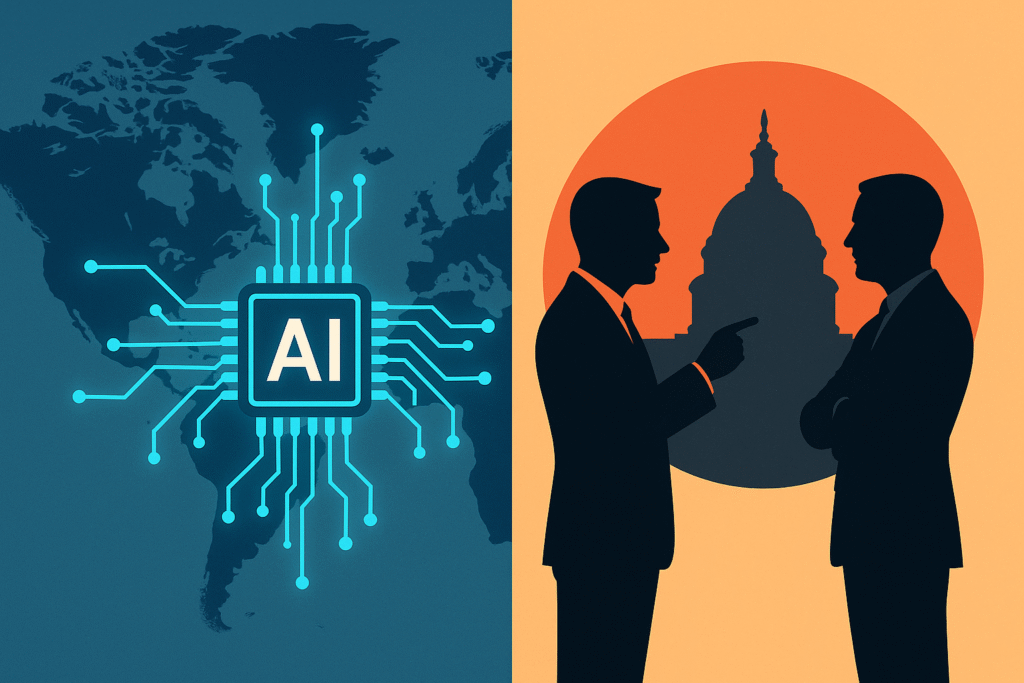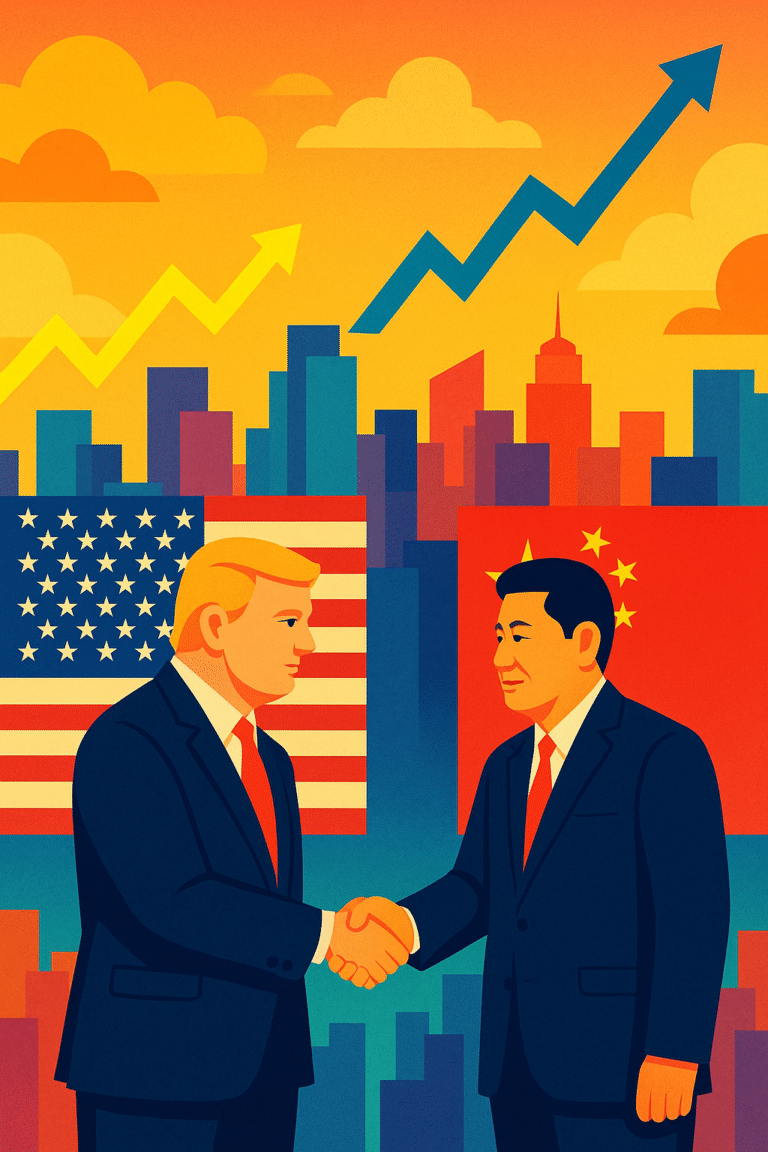Introduction
Artificial intelligence (AI) is evolving rapidly. It is reshaping the power dynamics around the world. Until now, the technology, particularly AI, has been dominated by Western tech giants, but now with the advancement of open source technologies, i.e. RISC-V chip, that is no more the case. For those who are new to the technology world, RISC-V (pronounced “risk-five) is an open-standard instruction set architecture for computer processors.
As the countries and tech giants compete with each other for dominance in the AI world, a critical question arises: Will AI consolidate power in the hands of a few, or will it democratize innovation, enabling emerging economies to compete? This article will delve into how AI is redefining economic and military influence, the ethical tightrope of regulation and the geopolitical implications of decentralisation.

The Rise of Open-Source Architecture: RISC-V as a Catalyst for Decentralization
Breaking the Silicon Oligopoly
Silicon Valley has been ruling the tech world for a long time. Proprietary designs like ARM and x86 were provided by it. But now, time is changing, and royalty-free alternatives are there in the market. For instance, RISC-V, managed by Switzerland, is offering royalty-free proprietary designs, thus disrupting the semiconductor industry. It allows countries in the world to design chips without any dependence on Western tech giants or their intellectual property (IP). Due to the same, countries like India, Brazil, and China are moving towards RISC-V. For instance, China’s SpacemiT V100 server CPU and India’s DIR-V program have reduced these countries’ dependency on US-controlled technologies.
Geopolitical Tensions and Fragmentation Risks
AI is expanding in the world of the US-China geopolitical rivalry. The competition is also impacting the evolution of AI. The tech rivalry between the two is also looming over the future of RISC-V. The USA government see the RISC-V as a threat to its tech dominance and wants to restrict its expansion, citing national security concerns. While China views it as a strategic leverage to bypass the US tech dominance. This risks dividing the world into different AI blocs with divergent standards, hence affecting the lives of consumers. China’s DeepSeek AI is a prime example of how China has challenged Silicon Valley and made the current US President Donald Trump call it a wake-up for America.
Emerging Economies: Leapfrogging into the AI Era
Trust and Adoption in the Global South
Trust is a major factor behind the usage of the internet. The more one trusts the app or website, the more users there will be. In 2025, KPMG and the University of Melbourne conducted a survey on the trust factor, showing that AI is not different from the trust factor. It revealed that 60% of people in emerging economies trust AI as compared to 40% in Advanced nations. For example, countries like Vietnam and Malaysia are looking for alternative supply chains of AI. Similarly, India’s DIR-V initiative is helping the country to design local chips to foster its economy, independent of Western influence.
AI’s Role in Economic Transformation
AI has impacted every part of our daily lives. That’s why emerging markets in the world are trying to use AI to bypass existing systems, technologies or equipment. In Healthcare, AI-driven diagnostics have been tested in rural African areas. It is enabling them to address doctor shortages. Similarly, countries in Southeast Asia are using AI predictive analytics to optimise crop production. Affordable automation is also available to the world due to Custom RISC-V chips, which could be used in the manufacturing industry. However, there is a major threat to this custom AI technology due to US chip export restrictions to force the world to remain dependent on Silicon Valley.
Ethical Dilemmas: Security vs. Innovation
The Shadow AI Crises
AI is helping us in almost all fields of industries around the world. But shadow AI, unregulated AI adoption, poses signification security risks to its consumers. Deploying an unregulated and unsanctioned AI tool in an industry could cause a leakage or breach of sensitive information. The 2024 Snowflake breach is a prime example of it. It exposed data from around 165 customers due to a campaign designed for data theft and extortion. The hackers used malware like Lumma, MetaStealer, and Raccoon to steal customer credentials and accessed Snowflake using them.
Regulatory Divergence: EU vs. US Approaches:
There is another dilemma in the evolving AI industry. Each major power of the world wants its own divergent regulations. The European Union has prioritised strict regulations like the GDPR and AI Act to mandate risk assessments and transparency in AI. However, there is a downside to such strict regulations as well. The startups often do not enjoy such restrictions. Moreover, the USA wants such a regulatory mechanism which gives an edge to Silicon Valley in every aspect. It has also faced criticism for such bias.
Ethical Flashpoints:
Three main ethical flashpoints could be in the field of AI. The tools used by AI to hire often disadvantage marginalised groups in the world. Racial groups, ethnic minorities, women or individuals with disabilities are prone to such bias. The issue is that AI can learn and replicate biases present in the data used to train the system. Similarly, between China’s social credit system and Western privacy norms, which surveillance would you choose or would you even choose any surveillance at all?.
China’s social credit system is a comprehensive surveillance and scoring system that monitors citizens’ behaviour and assigns them a credit score to certain norms and rules. It is assessed to be a serious infringement on privacy. Moreover, there is a whole lot of research going on about the impact of autonomous AI weapons, which could bring a revolution yet also devastation in military technologies.
Case Studies: Centralization vs. Decentralization
China’s Dual Strategy
China wants to balance open-source collaboration with state control over it. RISC-V and DeepSeek are its prime examples. China has developed its own processor known as the XiangShan processor. It is developed by the Chinese Academy of Sciences. It rivals ARM’s Cortex-A76. Thus, portraying Chinese self-reliance amid US sanctions.
Tech Giant’s Dominance
In competition with China, the US wants to keep its dominance in the tech world. The US firms like NVIDIA and Google are investing heavily in proprietary AI, i.e. Chatgpt, Gemini, etc,. Similarly, to retain influence in open source systems, they are also supporting RISC-V through initiatives like RISE Project.
The Path Ahead: Fragmentation or Collaboration?
Global Standards and Power Shifts
The future of AI depends on whether nations prioritize collaboration with each other to streamline the new evolving technology of AI or keep working in silos competing with each other on every front. It could be a collaboration like RISC-V. It is more than four thousand international members across 70 countries, exemplifying shared innovation around the world. However, there is a continuous threat of fragmentation to AI. Geopolitical rivalry could lead an incompatible AI ecosystems, thus threatening the lives of countries and tech companies. The prime example of fragmentation is a ban on 5G Huawei. How an evolving technology has been downsized due to geopolitics.
Policy Recommendations
There should be a balance between innovation and a safeguarding mechanism. Thus, adopting agile regulations would help AI to thrive in the world. Similarly, AI is for all, and everyone should benefit from it. Hence, investment should be made in open ecosystems like RISC-V and startups to counter geopolitical monopolies. Research should also be made on the accountability factor in the AI industry. This would help to reduce any harm(s) done through AI platforms or industries.
Conclusion
The geopolitical impact of AI is a double-edged sword. On the one hand, it helps emerging economies through decentralisation, while on the other hand, it also helps the dominance of tech giants. In this scenario, the rise of RISC-V and open source models can offer a middle path to the world. But ethical governance and global cooperation are required to save AI from a splintered future. It has become evident from the rise of Meta’s MTIA chip and China’s DeepSeek that the race for AI supremacy is not just about technology – it is about defining the rules of a new world order.



